Fast Fashion Market Research, 2032
The global fast fashion market was valued at $103.2 billion in 2022, and is projected to reach $291.1 billion by 2032, growing at a CAGR of 10.7% from 2023 to 2032.Fast fashion is a universal term in today's fashion industry and denotes a business model that is growing rapidly all across the world. Fast fashion trends within the fashion industry revolves around the rapid design, production, and distribution of clothing & accessories, to respond to the ever-changing urges of consumers and the latest trends spreading in the fast fashion industry. In essence, fast fashion brands are like lightning bolts, determined to bridge the gap between runway fashion and everyday wear in a matter of weeks, a feat previously unimaginable in the traditional fashion cycle.
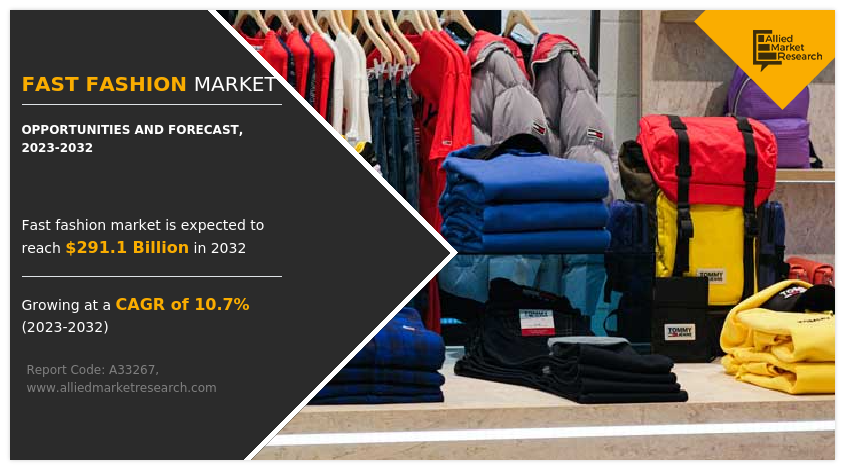
The driving force behind this phenomenon is affordability, a virtue that enables trendy clothing to be accessible to a broad spectrum of consumers. Achieving this affordability entails the utilization of cost-effective materials, labor, and manufacturing methods, all while keeping a vigilant eye on the haute couture trends of esteemed designers. It's a captivating dance between high fashion and cost-effectiveness, with the consumer as the ultimate beneficiary. For decades, fast fashion has held an iron grip on the fashion industry, thanks to its uncanny ability to rapidly adapt to consumer preferences and deliver chic garments at wallet-friendly prices.
However, beneath its glamorous façade lies a contentious issue - the ethical and sustainable implications of this model. Recent years have seen a seismic shift in consumer values, as sustainability and ethical considerations have moved to the forefront. Discerning shoppers are now seeking brands that prioritize transparency, fair labor practices, and environmentally responsible production methods over the breakneck pace of trend turnover synonymous with fast fashion. The ascension of fast fashion can be attributed to a medley of strategic elements, including robust marketing tactics and a formidable distribution network.
These factors are further amplified by the global spread of Western influences and a heightened awareness of health consciousness. In a parallel narrative, pistachios have experienced a similar surge in popularity, becoming a symbol of health and nutrition. Bursting with protein, fiber, and heart-healthy fats, pistachios have garnered a dedicated following. Their unique blend of taste and nutritional benefits resonates across diverse consumer demographics, transcending geographical borders. The enchantment of fast fashion knows no territorial boundaries, transcending regions to spark a global fervor.
The United States, China, and the European Union are pivotal players in this pistachio-like phenomenon, making fast fashion a global sensation. Within the realms of developed nations, fast fashion deploys a repertoire of enticing strategies. Retailers, adept at embracing the latest trends from runways and celebrity wardrobes, offer consumers the chance to stay perpetually "on-trend." The key allure lies in affordability, enabling consumers to effortlessly update their wardrobes with stylish clothing and accessories, all without breaking the bank.
Promotions, discounts, and time-limited sales events add to the allure, stoking the flames of consumer desire for fashionable bargains. In essence, fast fashion is an ever-revolving carousel of style, offering consumers the excitement of constant change and accessibility, but it also beckons them to ponder the ethical and sustainable consequences of their fashion choices.
The fast fashion market gains substantial momentum from the evolving demand of consumers for the latest trends. At its core, this fast fashion market demand is fueled by the innate desire of individuals to remain stylish, culturally connected, and relevant. For many, keeping pace with the ever-evolving world of fashion is a shared passion, and they eagerly embrace each new trend as it emerges.
To these fashion enthusiasts, clothing serves as more than just a practical necessity; it's a canvas for self-expression, a medium through which they articulate their unique tastes and personal identities. In an era dominated by social media, the influence of fashion icons and celebrities has reached unprecedented heights. These influencers effortlessly flaunt their ensembles and distinctive styles, capturing the attention and admiration of countless admirers.
Consumers, captivated by the glamour and allure of these fashion luminaries, yearn to replicate their looks and mirror their fashion sensibilities. This phenomenon has a profound impact on driving demand for clothing items that mirror those donned by these icons. Fast fashion brands astutely seize this opportunity by swiftly producing garments that draw inspiration from the outfits of celebrities.Hence, the burgeoning desire for trendy attire serves as a formidable catalyst, propelling the fast fashion market growth to greater heights.
The global fast fashion market size is segmented into gender, end user, distribution channel, and region.
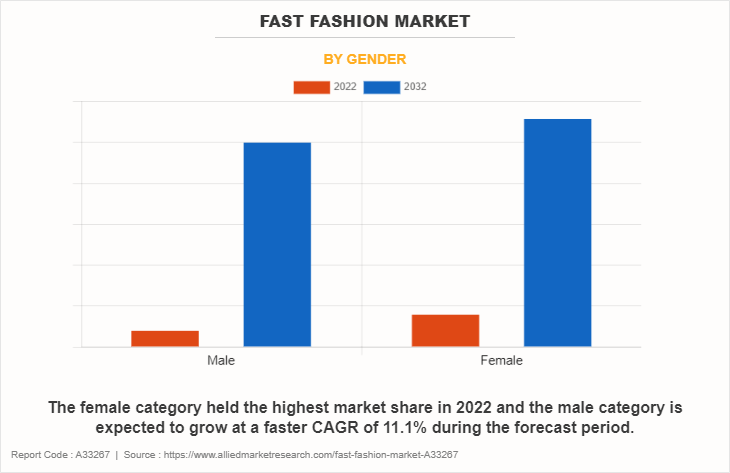
On the basis of gender, the fast fashion market is categorized into male and female. The male segment was the highest revenue contributor and is expected to remain dominant during the fast fashion market forecast period.
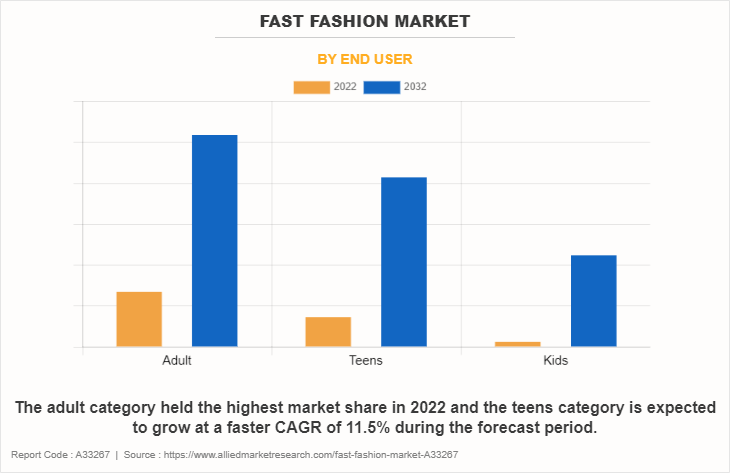
By end users, the fast fashion market is fragmented into adults, teens, and kids. The adult segment was the fastest growing segment in 2022, owing to the fact that adult consumers prefer more trendy clothes in the market.
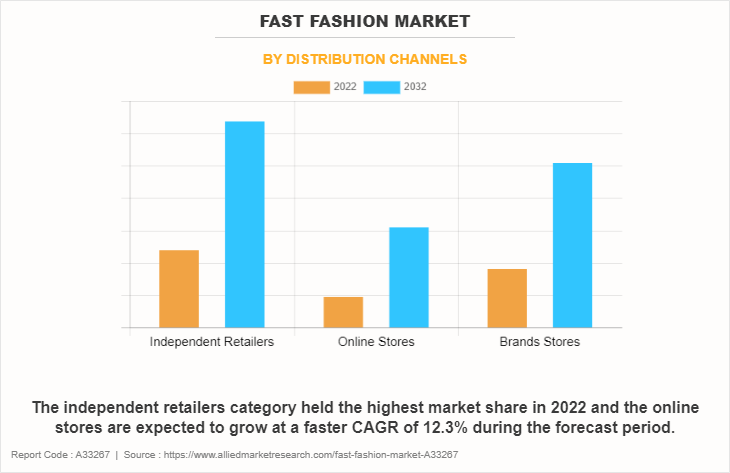
On the basis of distribution Channel, the fast fashion market is segmented into independent Retailer, online Store, and brand Store. Independent Retailer held a significant share in 2022. Moreover, the online Store and brand Store segments collectively accounted for around 35% of the global fast fashion market share.
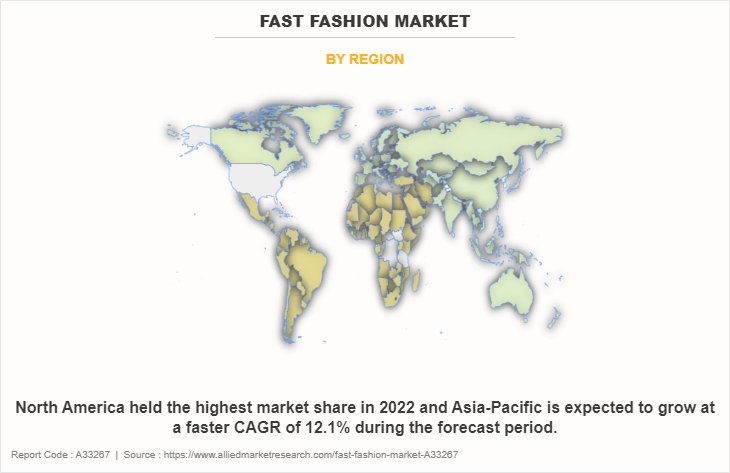
Region wise, it is analyzed across North America (the U.S., Canada, and Mexico), Europe (Germany, France, the UK, Spain, Italy, and rest of Europe), Asia-Pacific (China, Japan, India, Australia, and rest of Asia-Pacific), and LAMEA (Brazil, South Africa, UAE, and rest of LAMEA).
The key players profiled in this report are UNIQLO Co., Ltd., Forever21 Inc., The Gap, Inc., Primark Limited, Asos Plc, New Look Retailer Limited, H&M Hennes & Mauritz AB, Fashion Nova, LLC, Boohoo Group Plc, and Industria de Diseno Textil, S.A.
Key Benefits For Stakeholders
This report provides a quantitative analysis of the market segments, current trends, estimations, and dynamics of the fast fashion market analysis from 2022 to 2032 to identify the prevailing fast fashion market opportunities.
The market research is offered along with information related to key drivers, restraints, and opportunities.
Porter's five forces analysis highlights the potency of buyers and suppliers to enable stakeholders make profit-oriented business decisions and strengthen their supplier-buyer network.
In-depth analysis of the fast fashion market segmentation assists to determine the prevailing market opportunities.
Major countries in each region are mapped according to their revenue contribution to the global market.
Market player positioning facilitates benchmarking and provides a clear understanding of the present position of the market players.
The report includes the analysis of the regional as well as global fast fashion market trends, key players, market segments, application areas, and market growth strategies.
Fast Fashion Market Report Highlights
| Aspects | Details |
| Market Size By 2032 | USD 291.1 billion |
| Growth Rate | CAGR of 10.7% |
| Forecast period | 2022 - 2032 |
| Report Pages | 250 |
| By Gender |
|
| By End User |
|
| By Distribution Channels |
|
| By Region |
|
| Key Market Players | Asos Plc, Forever21 Inc., Primark Limited, Boohoo Group Plc, Industria de Diseño Textil, S.A., The Gap, Inc., New Look Retailers Limited, Fashion Nova, LLC, UNIQLO Co., Ltd., H&M Hennes & Mauritz AB |
Analyst Review
According to the insights of CXOs of leading companies, Asian consumers seek more trendy options in clothing such as fast fashion. Fast fashion sales are increasing in the India, China, and other developing economies, which is boosting the growth of global fast fashion market. Emergence and access to a wide range of Retailer are becoming increasingly crucial, thus providing manufacturers and merchants with lucrative growth opportunities. As consumers want unique alternatives to traditional clothes, such as trendy denim jeans, jackets, shirts, and other items, manufacturers are responding by developing products that are more suited to fast fashion.
The global fast fashion market was valued at $103.2 billion in 2022, and is projected to reach $291.1 billion by 2032, registering a CAGR of 10.7% from 2023 to 2032.
The forecast period in the market report would be 2023-2032.
The market value of fast fashion market in 2022 is $103.2 billion.
The year 2022 is base year calculated in the fast fashion market report.
The demand for fast fashion has been growing steadily in recent years as consumers become more stylish and trendier.
The key players profiled in this report are UNIQLO Co., Ltd., Forever21 Inc., The Gap, Inc., Primark Limited, Asos Plc, New Look Retailer Limited, H&M Hennes & Mauritz AB, Fashion Nova, LLC, Boohoo Group Plc, and Industria de Diseno Textil, S.A.
North America will dominate the market by the end of 2032.
Loading Table Of Content...
Loading Research Methodology...



